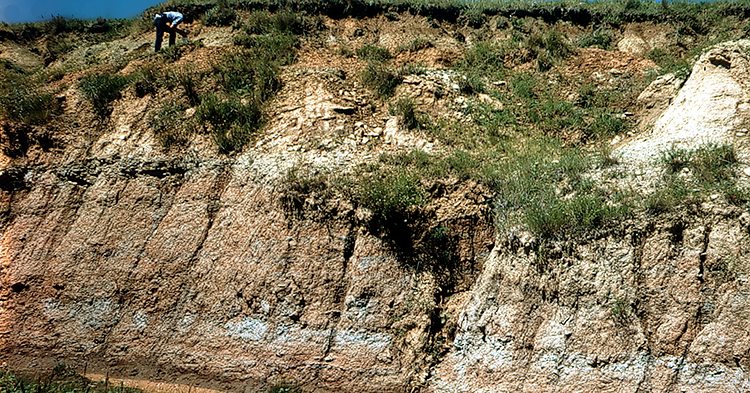Shale

Shale is a soft, brittle, fine-grained, and easily eroded sedimentary rock formed from mineral-rich silt, or mud, that was deposited in an aquatic environment, buried by other sediment, and compacted and cemented into hard rock. When exposed at the surface by erosion, shale weathers into thin layers called plates.
Often gray, shale can also be a variety of colors, including white, black, red, yellow, and green, due to the presence of impurities such as iron oxide (rust) and specific minerals. Shale is used to make bricks, tiles, and pottery, and it is mixed with limestone to make cement.
Many of the Permian and Pennsylvanian formations seen in outcrops and road cuts in eastern Kansas include layers of shale. It is also found in Permian outcrops in the Red Hills of south-central Kansas. Shale layers are often intermixed with limestone and sandstone layers. Each type of rock consists of sediment deposited at different depths in a sea or freshwater resource. Shale forms from muddy deposits that settle out in slow moving water, such as in deltas or along continental shelves. Sandstone forms from sandy deposits and limestone forms from deeper deposits.
Shale is a mudrock—a classification of rocks that are composed mainly of silt-sized or clay-sized particles (both microscopic). Siltstone, claystone, and mudstone are also mudrock. Different types of mudrocks are impossible to tell apart without looking at them under a microscope to determine grain size and other attributes.
The name "shale" traditionally has been widely used as an umbrella term, based on appearance, to refer to most mudrocks. Geologists are beginning to use the term "mudrock" more generally and reserving the term "shale" for a very specific type of mudrock.
Resources
Buchanan, R., 2010, Kansas Geology: An Introduction to Landscapes, Rocks, Minerals, and Fossils (2nd ed.): Lawrence, Kansas, University Press of Kansas, 240 p.
Buchanan, R., and McCauley, J. R., 2010, Roadside Kansas: A Traveler's Guide to Its Geology and Landmarks (2nd ed.): Lawrence, Kansas, University Press of Kansas, 392 p.
Kansas Rocks and Minerals, Kansas Geological Survey Educational Series 2